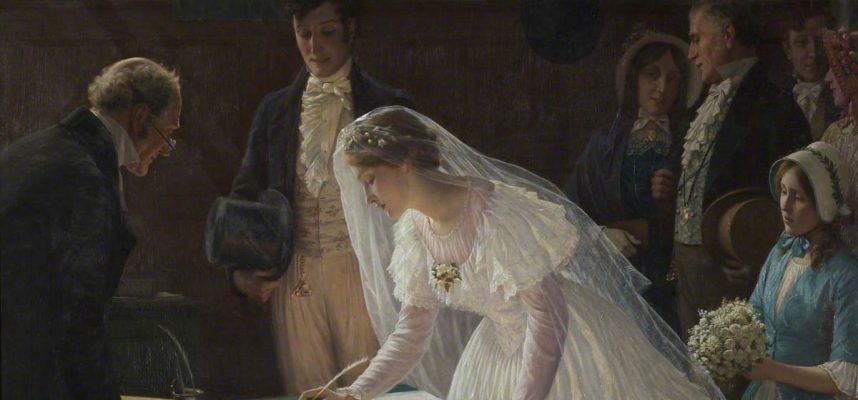

According to the latest available figures from the Office for National Statistics, civil marriages accounted for almost three-quarters of marriages celebrated in England and Wales in 2015. Yet it was only in the late twentieth century that civil marriage overtook religious marriage as the most popular form of marriage, and before the start of the twentieth century it was very much a minority choice.
So how were civil ceremonies perceived, and what were the practical considerations that may have shaped our ancestors’ actions?
Unlike in France, where civil marriage was introduced in the wake of revolution in the late eighteenth century, or Germany, where it was part of the process of unification in the late nineteenth century, the state never sought to make civil marriage the only option. Setting aside the short-lived form of civil marriage under the Commonwealth, marrying without religious rites first became an option in England and Wales under the Marriage Act 1836.
It is clear from the debates that reformers did not expect this new option to be popular. Those campaigning for reform had largely been non-conformist religious groups seeking the right to be able to conduct marriage ceremonies. Marriage in the register office was added in almost as an afterthought. In the first year of the new Act’s operation, just over 1 per cent of all weddings were celebrated in a register office, and even at the end of the nineteenth century they accounted for only 15 per cent.
For many individuals, a civil ceremony simply did not seem like a wedding. In a bigamy trial at the Old Bailey in 1850, Thomas Green told the court that he had been at the marriage of George Stiffell and Ellen Barratt but added that he ‘never saw such a marriage in my life—there was no ring put on—it was quite different to my own marriage.’ When arrested, George had admitted the marriage but objected that there was no minister present, clearly regarding this as an essential element.
Moreover, marrying in the parish church was often easier, quicker and cheaper than a civil marriage.
Given that all civil marriages had to be conducted in the register office, and that initially there would have been only one register office per registration district, the parish church would have remained the easiest option for most couples, particularly in rural areas.
For those who valued speed, the possibility of marrying by licence in the Anglican church was still the quickest route. While the legislation stipulated that a licence could only to be granted for a marriage to take place in the parish where at least one of the parties had been resident for 15 days, once this residential requirement was fulfilled there was no further waiting period. A special licence could also permit a marriage to take place at any time or venue.
By contrast, even the fastest form of civil preliminary – the superintendent registrar’s certificate by licence – involved a wait of 7 days, even after the residence requirement of 15 days had been satisfied. And the cheaper superintendent registrar’s certificate involved a wait of at least 21 days.
And despite the perception that marrying in the register office was the cheapest option, some vicars offered cut-price or free weddings to encourage couples to marry. At both Manchester Cathedral and St John’s church in the East End, vicars would routinely marry couples in batches to save time and money. And at St James the Great in Bethnal Green the vicar would marry couples for free, lest they simply cohabit without any ceremony.
Perhaps most surprisingly of all, the divorced were not barred from marrying in the Church of England. Before 1858 a clergyman had no legal basis for refusing to marry someone who had been divorced. And even after that date he was only exempted from solemnizing the marriage of the adulterous spouse.
For some, however, the greater privacy of the register office would have been the main attraction. It is telling that the proportion of bigamous marriages celebrated in register offices was significantly higher than the norm. There are also many examples of marriages within the prohibited degrees taking place in register offices over the course of the nineteenth century.
So the civil weddings of the past were very different from those of today – and we need to bear this in mind when interpreting our ancestors’ choices.
Professor Rebecca Probert, Professor of Law at University of Exeter, has written on all aspects of family law including informative guides for family history researchers: ‘Marriage Law for Genealogists’ and ‘Divorced, Bigamist and Bereaved’
Do you need help to find a marriage? Ask one of our experts here.